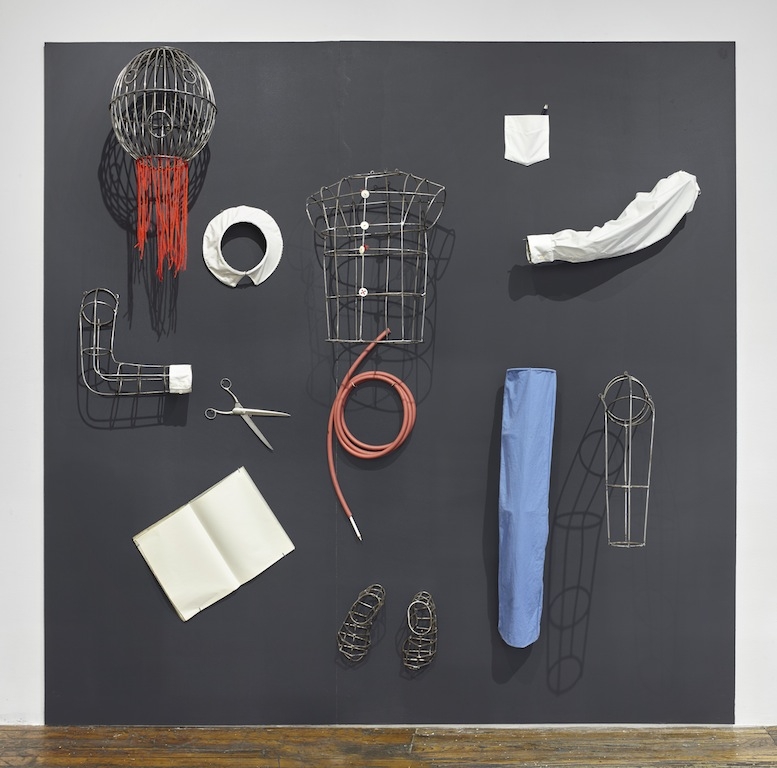For such a slight show, Eva Kot’átková’s ERROR raises a lot of relevant questions about mental illness, specifically, whether or not the mentally ill, by virtue of the disturbances of their minds, are tapped into some sort of creative genius that should not be controlled or suppressed but rather allowed to flourish. Consisting of a wall of collages, two installations of hanging sculptural assemblages, a puppet, a contraption for spying into people’s windows, and an hour-long video, the works on view make physical the visions of those who do not fit well with social convention and are often condemned to flounder in institutions such as the Bohnice Psychiatric Hospital in Prague, which was founded in 1909, and continues to operate today.
Kot’átková, who was born in Prague in 1982, and was old enough to remember the 1989 Velvet Revolution, when Czechoslovakia overthrew 41 years of oppressive Soviet rule, seems to equate the suppression of children in Communist schools — and, by proxy, Kot’átková herself — to the way adult mental patients were treated at Bohnice Psychiatric Hospital early in the Twentieth Century. Error (2015 – 16) is a series of 25 collages created from Czech books on education, sociology, psychology and nature, which show children bound, blinded, muted and contained in various ways. In one, a boy’s dismembered head hangs out of a wicker basket, his muted mouth emitting a stream of arrows that point to nowhere; in another, a smiling girl is wrapped in a furry outfit that, upon close inspection, reveals itself to be a straightjacket crudely adorned with the bow, rounded collar and buttons of a schoolgirl uniform.
More than art objects, the cages look like artefacts from some torture dungeon long condemned to history.
The collages hang opposite Error (Body of Viktor, “the electrician”) (2016), an installation of cages for body segments – head, arm, chest, leg — made in homage to Viktor, a patient at Bohnice in the 1920s, who thought that parts of his body fell off and went missing, especially during thunderstorms. More than art objects, the cages look like artefacts from some torture dungeon long condemned to history. What’s most interesting about the installation is the made-up diary of Viktor that hangs alongside the sculptures, in which the fictional Viktor writes: “I am at my most tranquil when writing or drawing. I wish they would leave me alone.” As if creative expression freed him from the horrors of his mind, and was more effective than any system of containment, which at Bohnice likely meant dulling routine, therapy, and medication.
The idea that a mentally ill person creates to free himself from not just an unsettled mind but also unbearable surroundings – just as an artist might – is continued in The Judicial Trial of Jakob Mohr (2015), the hour-long video that accompanies the show. It is based on the 1919 drawing by another Bohnice patient, Jakob Mohr, who shows himself on trial in front of a jury of doctors and fellow patients. Mohr thought that he was being controlled by an empty box that emitted electromagnetic waves. Rather than debunk this as ridiculous, the video gives him fair chance to make his case. Through the course of a trial, various witnesses are called. Mohr himself, his mother and father, his therapist, and an annoyed representative from the patent office to which Mohr kept sending empty boxes, are joined by ‘The Mechanical Boy’ and ‘Darger’s Girls’, visions of art brut artists Robert Gie and Henry Darger, respectively, who themselves were institutionalised at points in their lives.
The art brut visions believe in Mohr’s mind-control box and testify that it is real. The danger here, however, is that something as creatively unique as Darger’s incredible 15,145 page Story of the Vivian Girls… could be equated with an empty box just because the creators of both shared mental instabilities. It’s a mistake often made with the mentally ill – and I speak from within their ranks – that an unquiet mind, left to its own devices, is inherently capable of real genius.
What Kot’átková, and society at large, really admire is the conviction that the mentally ill, or artists, have in their delusions – think of how critics let Kanye West off the hook for his mess of a new album, The Life of Pablo, even though he Tweets that it’s the second coming of Jesus. Would any artist with a healthy mind be so sure of their own vision?
ISCP, Brooklyn, NY, 2 February – 19 April 2016
Online exculsive published 27 April 2016
